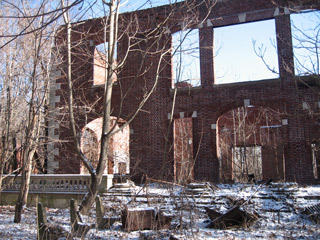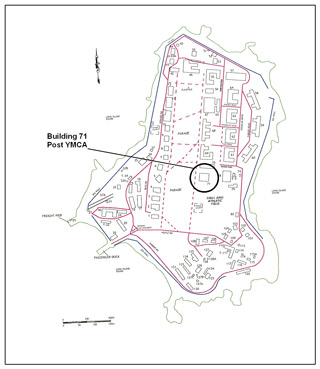|

DATE BUILT: 1909
STYLE: Neoclassical
PRINCIPAL ALTERATIONS: Minimal exterior alterations. Bowling alley converted to non-commissioned officers’ mess with bar (1950s).
OTHER DESIGNATIONS: Enlisted Men’s Service Club (1952-1965). Designated as Building 20 (1909-1941); Building 83 (1941-1957).

DESCRIPTION: The Young Men’s Christian Association (YMCA) building stood at the northwestern corner of the Drill Field and Recreation Area and faced the Parade Ground. It was a large building with facilities for recreational athletics, leisure-time pursuits, and social activities. The building was destroyed by fire sometime after 1986.
Fort Slocum’s YMCA was erected without government funds, and until 1952 it was not Army property. The New York City firm of Marshall L. and Henry G. Emery designed the building, making it one of the few on the post whose plans were developed by an outside architect.
The building’s main façade was a carefully balanced, classically-inspired design. A shallow, full-height tetrastyle portico—that is, an open porch supported by four columns—dominated the center of the façade around the main entrance. The portico stood on a narrow paved terrace approached by a short flight of steps and enclosed with a low masonry balustrade. There were large windows throughout the building, including broad, arched Palladian windows on the first story in the front. The building’s many windows made the interior seem light and airy.
Although the building was constructed primarily of red brick, the architects also used light-colored pre-cast concrete elements for contrast. The portico columns and terrace balustrade were both built of pre-cast components. Pre-cast concrete elements also served as quoins at the front corners of the building and as keystones, voussoirs, springers and lintels around window and door openings.
The YMCA building was divided into three sections that descended in height and area from front to rear. The front section contained a large common room called the Post Room and smaller meeting rooms and offices. The center consisted primarily of a recreation hall used for basketball and social events, but also included a billiard room and an apartment for the live-in chapter secretary, who managed building operations. The rear of the building had a bowling alley. After the Army purchased the building in the 1950s to be the Enlisted Men’s Service Club, it converted the bowling alley into the non-commissioned officers’ mess and bar.

HISTORICAL NOTES: The YMCA began providing facilities specifically for American soldiers and sailors around 1890. It offered soldiers and sailors wholesome recreation and Christian-centered activities, providing them with welcome refreshment from the wearying aspects of military life. Volunteers from New Rochelle and other Westchester communities and staff organized recreational athletics, established libraries, operated canteens, and provided other services.
During the Spanish-American War, YMCA staff and volunteers operated scores of facilities at military installations in the United States and overseas. This work was so successful for morale that in 1902 Congress authorized the International Committee of the YMCA to build and maintain facilities on any Army post. The legislation allowed the YMCA to promote the “social, physical, intellectual, and moral welfare” of enlisted men.
The Army Branch of the YMCA constructed the Fort Slocum building using a $50,000 gift from philanthropist Margaret Olivia Slocum Sage (Mrs. Russell Sage). Mrs. Sage may have been a distant cousin of Maj. Gen. Henry Warner Slocum (1827-1894), the prominent Union soldier and New York politician, for whom the post was named in 1896.
A plaque over a fireplace in the large common room at the front of the building acknowledged her contribution, declaring “This Building Was Erected… By Mrs. Russell Sage… As a Tribute to the Brave Men of the Army.”
After the First World War, the International Committee of the YMCA gradually reduced its recreation and welfare activities for Army and Navy personnel as it transferred these responsibilities to military authorities. This shift was largely complete by the Second World War. Even so, the YMCA continued to be involved in the lives of service personnel, but in a more limited role, as just one of many service organizations supporting America’s armed forces.
The YMCA remained active on Fort Slocum until 1950, offering enlisted personnel a place to read a book, write a letter, attend a dance, hear a band concert, see a revue, play a game of basketball or billiards, develop a hobby, participate in Bible study, or engage in any of a hundred similar leisure-time activities.
In 1951 the Army took over the YMCA building at Fort Slocum, rechristening it as Enlisted Men’s Service Club. It purchased the building outright in 1952. Though this change perhaps made the activities in the building a little less strait-laced, the overall purpose of the Service Club was similar to the YMCA.
|







